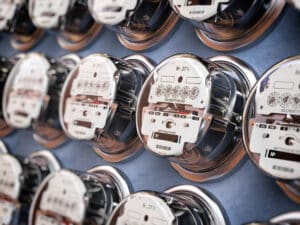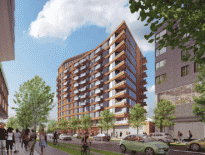
A draft energy code will let all-electric buildings be designed to less-stringent energy efficiency ratings.
Battle lines are forming as advocates of tougher voluntary energy codes weigh in on the state’s approach to meeting its carbon emissions-cutting goals.
“This update will make great improvements, but it won’t meet many of the needs of communities that are hungering for tools to require in new construction,” said Cammy Peterson, director of clean energy at Metropolitan Area Planning Council.
Massachusetts Department of Energy Resources is responsible for translating the goals of the state’s 2021 climate change legislation into specific regulations on building energy use and emissions. The law is designed to cut statewide carbon emissions by 50 percent by 2030 and attain net zero emissions by 2050.
Massachusetts’ existing voluntary stretch energy code has been adopted by 299 of the state’s 351 communities, and gives them the latitude to require more energy-efficient buildings than the base state building code. Pending updates to the stretch code, communities don’t have the authority to require more stringent standards. In 2020, Attorney General Maura Healey struck down a new Brookline bylaw banning the use of fossil fuel systems in new buildings, saying it didn’t have the authority to override the state building code.
In addition to the proposed new stretch code, DOER is proposing a separate “voluntary opt-in” code that would enable communities to adapt even more stringent requirements. But neither the new stretch code nor the voluntary opt-in code give communities the power to ban fossil fuel systems, nor to set new goals for major renovations.
“What we’d like to see carried over would be enabling cities and towns to require new construction to be built to net zero now,” Peterson said. “The buildings would be compliant with our 2050 [net zero] commitment as a state.”

Developers of some office, lab, hotel and retail properties in Boston, like Gazit Horizons in their proposed 120,000-square-foot expansion of the Marketplace Center office-retail complex, are proposing buildings that exceed current energy codes. Image courtesy of CambridgeSeven
Regulatory Incentives, Not Prohibitions
The state’s framework for new multifamily building requirements includes separate rules for low-rise buildings up to five stories and taller structures.
Under the updated stretch code, multifamily low-rises could comply by using fossil fuel, electric heating or Passive House designs. But fossil fuel-heated units would be required to meet a rating of 42 by the Home Energy Ratings System (HERS) index, an industry measurement of a residential building’s energy efficiency. That would likely require developers to spend up to an additional $7,900 per unit on other conservation techniques such as triple-glazed windows, according to DOER’s analysis.
By contrast, electrically-heated units would be required to attain the less stringent HERS 45 rating, translating into up to $28,000 in per-unit cost savings including incentive programs.
“We’re looking for more bolder codes that would allow new construction to be built right now to be in compliance with net zero and to move away from fossil fuels, rather than allowing that with a few new requirements,” MAPC’s Peterson said.
DOER officials released a “straw proposal” for the new regulations in February, and the agency has scheduled five regional public hearings on the two new codes from March 2 through March 8. A public comment period runs through March 9, and the final codes are scheduled to be approved by January 2023.
In a statement, the Massachusetts Sierra Club said communities “cities should have the authority to protect the health and safety of their communities by phasing out gas hookups in new homes and buildings—but Gov. [Charlie] Baker’s energy code proposal does not provide them that opportunity for leadership.”
Boston-based Conservation Law Foundation is still reviewing the proposed codes, spokesman Jake O’Neill said.
Developers Take Voluntary Steps
Some for-profit commercial developers are already incorporating building systems that exceed the current energy codes, noted Jacob Bloom, an associate at CambridgeSeven architects. They’re anticipating that local and state regulations will force them to retrofit buildings anyway, and anticipating that up-front costs will continue to decline as more efficient building systems gain widespread adoption.
A proposed 120,000-square-foot expansion of the Marketplace Center office-retail complex at 200 State St. in Boston is designed with all-electric heating and cooling systems. Developer Gazit Horizons plans to use air- and water-source heat pumps with heat recovery systems and a solar array to exceed the requirements of the existing stretch code, according to a consultant’s analysis submitted to the Boston Planning & Development Agency.
Variable refrigerant flow heating and cooling systems, which capture excess heat for recirculation in buildings, allow for steep reductions in overall energy usage. Two proposals in the Fenway – a 550,000-square-foot office-lab building at 401 Park Drive and a 247,000-square-foot life science building at 109 Brookline Ave. – are designed with heat recovery chillers that recycle excess heat throughout the buildings. Alexandria Real Estate Equities, the nation’s largest life science landlord, says its 401 Park Drive building would derive 96 percent of its heating from electricity.
Some hotel developers also are embracing the benefits of variable-flow refrigerant systems to reduce operating costs. The proposed 134-room Cross Street Hotel in Boston’s North End is designed with air source heat pumps, a solar array and triple-paned windows, resulting in a projected 26 percent reduction in energy usage compared with the state energy code baseline.

Steve Adams
The hotel is designed to use 26 percent less energy than required by the Massachusetts energy code, according to project filings, through building envelope design and high-efficiency HVAC and hot water systems.
But an outright ban on fossil fuels in commercial buildings would complicate designs for mixed-use developments that include restaurants, which typically prefer gas appliances, said Michael Liu, senior partner and design principal at The Architectural Team in Chelsea. And while the efficiency of latest-generation electric heat pumps offsets the higher cost of electricity, there’s no guarantee that rates won’t rise if a massive migration toward electrical systems pushes up demand on the grid, he said.
“Everyone focuses on the efficiency of the system, but right now electricity is five times more expensive,” Liu said. “Over time, one assumes the cost per BTU of the electricity is going to come down with greater capacity.”





